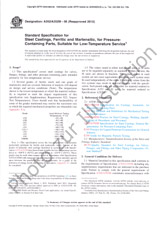Wir benötigen Ihre Einwilligung zur Verwendung der einzelnen Daten, damit Sie unter anderem Informationen zu Ihren Interessen einsehen können. Klicken Sie auf "OK", um Ihre Zustimmung zu erteilen.
ASTM D5191-15
Standard Test Method for Vapor Pressure of Petroleum Products (Mini Method)
Automatische name übersetzung:
Standard Test Method for Dampfdruck von Erdölprodukten ( Mini -Methode)
NORM herausgegeben am 1.10.2015
Informationen über die Norm:
Bezeichnung normen: ASTM D5191-15
Anmerkung: UNGÜLTIG
Ausgabedatum normen: 1.10.2015
SKU: NS-617124
Zahl der Seiten: 10
Gewicht ca.: 30 g (0.07 Pfund)
Land: Amerikanische technische Norm
Kategorie: Technische Normen ASTM
Kategorie - ähnliche Normen:
Die Annotation des Normtextes ASTM D5191-15 :
Keywords:
dry vapor pressure, gasoline, hydrocarbon-oxygenate blends, mini method, petroleum products, vapor pressure,, ICS Number Code 75.080 (Petroleum products in general)
Ergänzende Informationen
| Significance and Use | ||||||||||||||||||
|
5.1 Vapor pressure is a very important physical property of volatile liquids. 5.2 The vapor pressure of gasoline and gasoline-oxygenate blends is regulated by various government agencies. 5.3 Specifications for volatile petroleum products generally include vapor pressure limits to ensure products of suitable volatility performance. 5.4 This test method is more precise than Test Method D4953, uses a small sample size (1 mL to 10 mL), and requires about 7 min to complete the test. |
||||||||||||||||||
| 1. Scope | ||||||||||||||||||
|
1.1 This test method covers the use of automated vapor pressure instruments to determine the total vapor pressure exerted in vacuum by air-containing, volatile, liquid petroleum products, including automotive spark-ignition fuels with or without oxygenates (see Note 1). This test method is suitable for testing samples with boiling points above 0 °C (32 °F) that exert a vapor pressure between 7 kPa and 130 kPa (1.0 psi and 18.6 psi) at 37.8 °C (100 °F) at a vapor-to-liquid ratio of 4:1. Measurements are made on liquid sample sizes in the range from 1 mL to 10 mL. No account is made for dissolved water in the sample. Note 1: An interlaboratory study was conducted in 2008
involving 11 different laboratories submitting 15 data sets and 15
different samples of ethanol-fuel blends containing 25 volume %, 50
volume %, and 75 volume % ethanol. The results indicated that the
repeatability limits of these samples are with in the published
repeatability of this test method. on this basis, it can be
concluded that D5191 is
applicable to ethanol-fuel blends such as Ed75 and Ed85
(Specification D5798) and
other ethanol-fuel blends with greater than 10 v% ethanol. See ASTM
RR: D02–1694 filed with ASTM for supporting data.2
Note 2: Samples can also be tested at other vapor-to-liquid
ratios, temperatures, and pressures, but the precision and bias
statements need not apply.
Note 3: The interlaboratory studies conducted in 1988, 1991,
and 2003 to determine the precision statements in Test Method
D5191 did not include any
crude oil in the sample sets. Test Method D6377, as well as IP 481, have been shown
to be suitable for vapor pressure measurements of crude
oils.
1.1.1 Some gasoline-oxygenate blends may show a haze when cooled to 0 °C to 1 °C. If a haze is observed in 8.5, it shall be indicated in the reporting of results. The precision and bias statements for hazy samples have not been determined (see Note 15). 1.2 This test method is suitable for calculation of the dry vapor pressure equivalent (DVPE) of gasoline and gasoline-oxygenate blends by means of a correlation equation (see Eq 1 in 14.2). The calculated DVPE very closely approximates the dry vapor pressure that would be obtained on the same material when tested by Test Method D4953. 1.3 The values stated in SI units are regarded as standard. The inch-pound units given in parentheses are provided for information only. 1.4 1.5 This standard does not purport to address all of the safety concerns, if any, associated with its use. It is the responsibility of the user of this standard to establish appropriate safety and health practices and determine the applicability of regulatory limitations prior to use. For specific safety warning statements, see 7.2 through 7.8. |
||||||||||||||||||
| 2. Referenced Documents | ||||||||||||||||||
|
Empfehlungen:
Aktualisierung der technischen Normen
Wollen Sie sich sicher sein, dass Sie nur die gültigen technischen Normen verwenden?
Wir bieten Ihnen eine Lösung, die Ihnen eine Monatsübersicht über die Aktualität der von Ihnen angewandten Normen sicher stellt.
Brauchen Sie mehr Informationen? Sehen Sie sich diese Seite an.




 Cookies
Cookies
